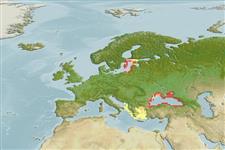>
Gobiiformes (Gobies) >
Gobiidae (Gobies) > Gobiinae
Etymology: Neogobius: Greek, neos = new + Latin, gobius = gudgeon (Ref. 45335).
More on author: Pallas.
Environment: milieu / climate zone / depth range / distribution range
Sinh thái học
Biển; Nước ngọt; Thuộc về nước lợ gần đáy; sống cả ở nước ngọt và nuớc mặn (Ref. 46888); Mức độ sâu 0 - 30 m (Ref. 36771). Temperate; 4°C - 20°C (Ref. 2059); 60°N - 36°N, 18°E - 58°E
Europe and Asia: Sea of Azov, Black Sea and Caspian basins. Adverse ecological impact after introduction have been reported by several countries. In 2004, this was accidentally introduced in North America with ballast water in ships (Ref. 59043).
Length at first maturity / Bộ gần gũi / Khối lượng (Trọng lượng) / Age
Maturity: Lm ?, range 4 - ? cm
Max length : 35.0 cm TL con đực/không giới tính; (Ref. 88073); Khối lượng cực đại được công bố: 381.42 g (Ref. 88073); Tuổi cực đại được báo cáo: 6 các năm (Ref. 110985)
Các tia vây lưng cứng (tổng cộng): 7 - 8; Các vây lưng mềm (tổng cộng): 12-17; Tia cứng vây hậu môn 1; Tia mềm vây hậu môn: 9 - 14; Động vật có xương sống: 31 - 34. This species is distinguished from its congeners entering freshwater in Europe by the following characters: first branched ray of second dorsal about as long as penultimate ray; no scales on midline of nape, in front of preoperculum; pelvic-disc fraenum with small rounded lobes and the length is less than 1/6 of width at base; scales in midlateral series 45-54 + 2-3; a large black spot on the posterior part of first dorsal (Ref. 59043).
Prefer shallow, brackish waters but also occur in fresh waters (Ref. 36771); in lagoons and lakes, large rivers, harbors, on sand or rock bottom; mostly found on well vegetated or rock bottom (Ref. 59043). Can tolerate a temperature range of 0 to 30°C, but mainly thrive in warm
temperate waters; able to tolerate low oxygen content waters for several days (Ref. 36771). Oviparous, with demersal eggs (Ref. 36771). Longevity up to 4 years. Males reproduce for the first time at 3-4 years, females at 2-3 years. Spawning season in April to September; females may repeat spawning during a season, every 18-20 days; body of males entirely black during this season. Adhesive eggs deposited on stones, shells and aquatic plants; males guard eggs until hatching and usually die after spawning season. Egg clutches are supposed to be occasionally transported attached to the hull of ships, facilitating introduction to other areas. Feeds on a wide variety of invertebrates and small fish, mostly on molluscs (Ref. 59043). Due to its large size, it has a major commercial value in some areas, especially in Azov Sea. It is usually salted, dried and consumed with beer (Ref. 92840).
Males protect embryos and juveniles (Ref. 36771). Males die after the spawning season (Ref. 36771).
Kottelat, M., 1997. European freshwater fishes. An heuristic checklist of the freshwater fishes of Europe (exclusive of former USSR), with an introduction for non-systematists and comments on nomenclature and conservation. Biologia, Bratislava, 52/Suppl. 5:1-271. (Ref. 13696)
IUCN Red List Status (Ref. 130435)
Threat to humans
Potential pest
Human uses
Các nghề cá: Tính thương mại; Bể nuôi cá: Tính thương mại; mồi: occasionally
Các công cụ
Special reports
Download XML
Các nguồn internet
Estimates based on models
Preferred temperature (Ref.
123201): 8.1 - 16.4, mean 14.2 °C (based on 168 cells).
Phylogenetic diversity index (Ref.
82804): PD
50 = 0.5625 [Uniqueness, from 0.5 = low to 2.0 = high].
Bayesian length-weight: a=0.01122 (0.00950 - 0.01325), b=3.04 (2.99 - 3.09), in cm total length, based on LWR estimates for this species (Ref.
93245).
Mức dinh dưỡng (Ref.
69278): 3.3 ±0.1 se; based on diet studies.
Thích nghi nhanh (Ref.
120179): Trung bình, thời gian nhân đôi của chủng quần tối thiểu là 1.4 - 4.4 năm (tm=2-4; tmax=4; Fec=300).
Fishing Vulnerability (Ref.
59153): Moderate vulnerability (36 of 100).
